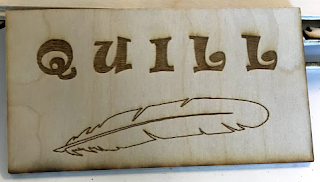A conversation with materials
 |
| My work |
Laser cutting seemed scary to me at first. The long “instruction
manual” was intimidating too. But these first intuitive responses were all
caused by my ignorance of the new tools. This is exactly why MILL is
attractive: it allows you to conquer the fear by leading you through an easy conversation
with those materialistic strangers so that they are not intimidating any more. Petrich, Wilkinson and Revan (2013) observe
that innovation happens when new tinkering strategies emerge through growing
understanding of tools, materials, and phenomena (p.54).
I was fortunate enough to be able to observe the whole process
of the project made by a fellow student before me. She wanted to create a name
tag for her grandson named Quill. She started by choosing her favorite font from
Adobe Illustrator for the letters and she liked the font that makes the letters
look a little cute. Then she wants to have a feather put horizontally under the
name. I suddenly realized the implication of the combination: quill is also a
pen. I marveled at the design, which was simple, but very meaningful. She googled
for pictures of feather. At first she chose a very intricate one with delicate
lines. But the student assistant suggested her not to take that one, because the
laser cutter wouldn’t be able to capture those details. So she opted for one
with bold lines. Then she would have to decide whether it was to cut through or
engrave. Again, considering the material she’s going to use (plywood) and the
artistic style she wanted, she chose engraving. Twenty minutes later, her artwork
turned out to be the way she liked.
 |
| My colleague's work (with permission) |
My observation of her conversation with Illustrator, the laser cutter and plywood enabled me to have a better understanding of these materials I was going to work with. I was less scared, and the project which used to be so intimidating became more transparent. I came to realize that the laser cutter was something like an average printer in that it helps us print out something on different materials, such as plywood, acrylic, etc. Instead of administering artistic moves directly on those materials, we mediate our design with computer software and the laser cutter. Human beings have never ceased to create extensions of themselves: they created wheels to extend their legs, cranes to extend their arms, telescope to extend their eyes and phones to extend their ears. Now they have created something to extend their artistic talent and imagination.
This brings home to me what Petrich et al. (2013) consider
as one of the principles of maker space design: “We select materials or
phenomena largely on two criteria: their inherent potential to be sensually and
aesthetically evocative and their potential to provide immediate feedback to
the tinkerer’s actions (p.59).” Both of us chose plywood because we wanted to
make something reminiscent of antiquity, a typical artistic sensation associated
with wood. We got our direct feedback 20 minutes later, immediately indeed!

Comments
Post a Comment